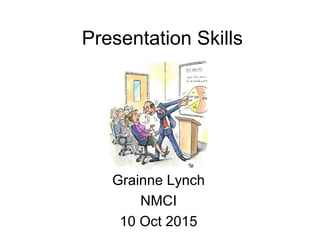Presentation Skills by Grainne Lynch CMILT
- 1. Presentation Skills Grainne Lynch NMCI 10 Oct 2015
- 2. Fear
- 3. The Fear Factor 1. Fear of public speaking 2. Fear of death and end of life 3. Fear of spiders and other arachnids creatures 4. Fear of darkness and twilight 5. Fear of heights, altitude or elevations 6. Fear of people or social situations 7. Fear of flying 8. Fear of open spaces and squares 9. Fear of natural thunder and lightning 10. Fear of confined spaces or small rooms
- 6. Why Presentations Fail • Audience stops paying attention
- 7. Eyes
- 8. Eye Contact • Cultural – Some cultures – deference • Interest & trust • Soft focus • Scan the room • Give audience members the same eye time
- 9. Pause
- 10. Pause • Allow audience time to take in information • Allow audience time to think and frame what you are saying • Give yourself time to think • Not too long • Not too short
- 11. Body Language
- 12. Body Language • Hands – out of the pockets • No keys or coins
- 13. Hand Gestures
- 14. Hand Gestures • Emphasise the point • Draw attention back to you • Convey energy • Convey passion
- 15. Move
- 16. Move • Component of your message • Move – match the flow of your presentation • Move in a way that is comfortable • Avoid movement that is ‘habit’ • Give audience a change of view • Keep eye contact
- 17. Humour
- 18. Jokes • Does humour come to you naturally? • If not, best to avoid
- 19. Stories
- 20. PowerPoint
- 21. PowerPoint • Can you manage without it? • Less is more • Rule of thumb – 6 lines, 6 words per line
- 23. Effective Content • Know your audience • Know what they want to hear • Know what they do not want to hear • Get to the point • Emphasise the point
- 24. Practice
- 25. Practice • Do not learn your presentation • Know the sequence • Know where to pause • Know when to gesture • Rehearse your presentation
- 26. Recovering from Stage Fright
- 27. • Cause: Anxiety and Fear • Remedy: Admit, Relax, Ask for Help Recovering from Stage Fright
- 28. Presentation Structure • GRAB – Grab audience’s attention • TELL – Get to the point • BANG – Leave audience with something to think about
Editor's Notes
- Essentials of good presenting skills Next time you hear someone present, you will know why it was good. You’ll know why it was bad/ You’ll be screaming at them “STOP DOING THAT”
- According to most studies, people’s number one fear is public speaking. Number two is death. Death is number two. Does that seem right? That means to the average person, if you have to go to a funeral, you’re better off in the casket than doing the eulogy.Jerry Seinfeld
- Dan Watson
- Every movement that a speaker makes means – or should mean – something. Hence avoid indulging in movements which are purely habit and which mean nothing. Do not constantly be moving; it makes the audience also restless. Do not walk back and forth along the edge of the platform like a caged lion. Do not shrug your shoulders, or twist your mouth, or make faces.

